| Robot Science & Technology |
|
|||||
|
Stiquito Kit BattleKits Robot Toys Solar Kits Robot Arms Robosapien Basic Stamp Kits Lego MindStorms
Hobby Robots Robot Sports Electronics Mechanics Robot Minds Books for Kids Robots at Work Microcontrollers Advanced Books Used Books
Robot Motors Remote Controls Robot Parts Robot Tools Magazines Robot Videos Robot News RoboLinks Contact
|
Robot Science & Technology Magazine is no longer available. We suggest
SERVO Magazine:
In addition to hands-on robotics projects, Servo will delve deeper into the science of robotics and take you right to the lunatic fringe of what robotic technology is all about. A definite must-read for anyone interested in building or learning about robots. Amazing machines are being conceived and built in labs, universities, and even garages all over the world and Servo Magazine is your ticket in the door. Each monthly issue will inspire, educate, and entertain with feature articles, interviews, tutorials, projects, and sources for parts. Whether you're building your first line-follower or finishing off the perception layer in a positronic brain, Servo Magazine delivers the sharp technical tools you need to stay on the cutting edge. |
|||||
|
Mark presents a thorough review of mechanical design concepts of the OWI
arm, describes how to add position feedback to each of its joints and explains the
technique of interfacing your embedded controller. Topics include: OWI Arm Basics, Gripper
Mechanical Design, Instrumenting the Gripper, Object Detection, Finger Position Detection,
Wrist Mechanical Design, Instrumenting the Wrist, Elbow Mechanical Design, Instrumenting
the Elbow, Shoulder Mechanical Design, Instrumenting the Shoulder, Base Mechanical Design,
Instrumenting the Base, Computer Control, and Sensing Position.
The C* Algorithm does two things, unlike the A* in our last issue which
did nothing but plan. This algorithm plans and then, using time outs in the planning
process, gives your robot direction based on that planning for its next move. A thinker,
and a doer. However, what it may not do is find the shortest and fastest way through
a maze. But, at least your robot is on its way! This unique algorithm is useful if your
robot has a movement to make but insufficient time to plan the entire activity prior to
starting the move. FIRST Robotics - 1999 National Championships RS&T's Floyd Painter describes one of the worlds largest robotic competitions. The championships were held at EPCOT Center in Orlando, FL and were attended by the RS&T staff (not to mention the teams, sponsors, guests, press, etc. who numbered in the thousands!). Over two hundred teams competed. Catch the spirit, excitement, and color of this major robotic event which pitted teams comprised of professionals, students, and faculty advisors from United States and Canada against each other. The founders of FIRST, Dean Kamen and Woodie Flowers, explain what it is all about in an exclusive interview with the RS&T staff. FIRST LEGO League Pilot Competition What a combination! FIRST and the LEGO Co. joining forces to stimulate learning about science, technology, and robotics. Why wait until high school to get a basic understanding of computers, programming, and robotics in general? Enter the FIRST LEGO League (FLL) - devoted to bringing all this to youngsters and making sure they have FUN along the way. This article, by Technical Editor, Gene Ronan, will give you a feel for the philosophy behind the league, the challenge, and the future of the FLL. Motion Control with R/C Servos Let's get our robots moving! Do you like mimes doing the herky-jerky robot routine? It sure looks funny and is not at all how we would like our android robots to perform. We may not be able to achieve the grace of a ballet dancer but by using the techniques that Joseph Miller outlines we should start to make progress toward smooth motion. Joseph Miller, owner of Positive Logic Engineering, contributes his ideas on inertia, acceleration, deceleration, and many of the problems robots encounter along the way to graceful movement. More than just theory, motion scripts are included to help your robot on its way. Happy Trails! Infrared Sensors from Sharp While your robot is happily, and hopefully smoothly, moving down the trail, how do we keep it from running into walls, chair legs, people, etc.? Two recent additions to your arsenal of avoidance gear are the GP2D02 and GP2D05 Infrared Detectors from Sharp. Steve Richards, of Acroname Inc., describes their similarities and differences and offers advice on interfacing, beam patterns, and tricks and tips for using this hardware to best advantage. Included are code snippets for their programming.
Now you can get hands on experience in a jiffy! No need to make your own parts or hack something else to get started. The LEGO Company has entered the robotics field in a big way with the introduction of their Mindstorms Robotics Invention System. Just start popping the pieces together and in no time at all you have an working robot! Dr. Bob Brady points out that, as with all things LEGO, this kit is infinitely expandable. Dr. Bob builds and programs the Torbot, and lets us know what he thinks of the kit. The LEGO Mindstorms Kit Taking a different tack, Dr. Tak Auyeung looks at the Mindstorms kit from a technical angle. He gives us useful data on stall current of the LEGO motors, their efficiency, torque, etc. He also covers the touch sensors, brains (RCX), and other parts of interest. Summing up, he mentions some of the 'missing features,' and suggests areas where LEGO could improve the kit. This is a 'must read' for those contemplating using the kit for advanced prototyping.
A hackers delight! Chris Harriman details how he combined some readily available parts to produce a unique robot. He takes a Lynxmotion, Inc. H2-KT Hexapod II Walker, a BasicX microprocessor, a Polaroid sonar sensor from an old camera, and a nice size battery and creates the robot of his dreams. Adding the capability to control the bot with a joy stick allows you to get everything working smoothly before you let Fluffy go it alone. Its all here in stunning color from theory to execution - code included! Construction: This one gets you going in a hurry! George York and Shelley J. Christopher present some ideas on how to set the mid position on servomotors without having to use the microprocessor. This comes in handy when you are trying to find out just how big the envelope of your Walker will be prior to designing a skin to dress it up. It also covers motor positioning and mounting, and construction and mounting of the legs. You will get a very good idea of the overall size of you bot right up front.
Our good friend and Contributing Editor, Dr. Tak Auyeung of the University of California, Davis presents another interesting algorithm. This one, believe it or not, does nothing! Well, actually, it doesn't do anything physical. Why, you ask? Because it is an algorithm that plans. A thinker, not a doer. However, what it does do is find the shortest and thus the fastest way through a maze. It will amaze you! Intelligent Evolving Soccer Robots Part II:
FIRST Robotics: Gunn High School FIRST Team
From Conception to Creation:
New Product Update: A tutorial handbook of microcontroller basic knowledge and experiments, plus a companion breadboard, make for a fun and exciting learning experience. The Board of Education, a prototyping breadboard, introduces the student to electronic fundamentals without the pain normally associate with things electronic. Feed Your Head (book review): This textbook is designed for use in an educational setting. Entering Artificial Intelligence students, directed and assisted by their professors, will find a wealth of information and ideas coherently arranged and concisely presented. Topics include Reactive Machines (Stimulus-Response, Neural Networks, etc), Searches in State Space, Knowledge and Reasoning, Planning Methods Based on Logic, Communication and Integration, and more. Fabrication: The Hexapod Walker Comes to Life! Part I
This issue of RS&T highlights affordable robots, and the cover features GrowBot from Parallax. The magazine also includes a unique segment on kits and ready-to-roll machines in a Twenty-First Century Robot Showcase. Here is information on some popular robots, where to get them and how much they cost. FIRST, Robotics Partnering Industry and Youth:
Building an Inexpensive Insectoid Robot: The Art of Robot War
Popular Micromouse Algorithms, Part III: This is the third in a series of articles that discuss algorithms used by Micromouse robots to solve a maze in competition. IEEE chapters have organized these annual competitions all over the U.S. and they have enjoyed a steadily rising popularity. While the exact rules differ among the competitions, the main objective remains the same: use a robotic "mouse" to solve the maze as quickly as possible. The basic premise of the problem is that the Micromouse robot does not know the configuration of the maze before its first run in the maze. The coordinates of the destination, on the other hand, are known. The robot is allowed to store information and repeat solving the maze within a time limit. In previous issues, we presented the Wall Hugging and Depth-first Search algorithms. The subject of this article is the Flood-fill Algorithm, which works for mazes that have known coordinate-designated destination cells. Vacuforming on a Shoestring
The technological spotlight falls on soccer-playing robots in the November issue. Two features delve into the ability of teams of autonomous robots to perform all the functions of human soccer players, cooperating with each other toward common goals in adversarial situations. These informative features discuss computing techniques and system architectures that allow robots to cooperate effectively as teammates in a complex, dynamic environment. The Sony Corporation entertainment-type convertible bot appears on the cover in its wheeled configuration, and on the centerfold as a quadruped walker. Do-it-yourselfers will love the articles on plastic gear fabrication, converting servomotors into rotary motors, and how to choose the right motor for a robot. Our construction series continues with a how-to on designing and assembling a combat robot, written by a veteran warrior, and the second in a series of Micromouse maze articles discusses the principles and the algorithm behind the depth-first search method. The departments are thought provoking and informative, highlighted by the presence of the all-seeing, all-knowing Iconoclast. Don't worry, he's one of us. Intelligent Evolving Soccer Robots: Part I
Walking Soccer-Playing Robots
In robotics, the weight of the components of your robot can work for you --or against you. This is the third article in our plastic fabrication series. In this article, we show you how replacing metal with plastic where practical can dramatically lower the weight and improve the performance of your robot. For demonstration purposes, we've chosen a steel alloy gear and asked our fabrication specialist Rick Hahn to make an identical gear out of plastic. This article leads you through the not very complicated process of replicating metal gears in plastic. From Conception to Creation:
Modifying a Futaba FP-S148 Hobby Servo Motor for Use as a Robot Motor Electric motors make things happen, without them our robots are ... NOT. Unfortunately, they usually do not come equipped to do anything but spin. We need to gear them down to have them perform useful work. However, not many of us have the time to build, or the cash to buy the necessary gearboxes. Luckily, a solution is at hand in the form of servomotors that can be converted to perform as regular motors and come complete with gearboxes. Karl Lunt explains in this article how this conversion is accomplished. Motor Selection and Performance Building a robot requires many decisions. Everything from the type of sensors you want, to the color you will want to paint it. Some of these decisions are trivial, others will make or break your robot. One decision that is in the make-or-break category is motors, not just which ones to use, but how to optimize their performance. Most robots use a particular kind of motor, the permanent magnet direct current (PMDC) motor. The discussion in this article is limited to PMDC motors. Also covered are factors you should consider before you choose a motor, including power requirements, over-volting, heat dissipation, the use of resistors, and how to use controllers to control 'on' and 'off' time. Popular Micromouse Algorithms, Part II: The second in a series of articles that discuss various algorithms used by Micromouse robots to solve the Micromouse maze. In the July 1998 issue, we explained the terminology used, basic robot abilities, and exploring the maze. We employed the "wall hugging" algorithm and discovered its main fault. This article discusses another, more successful, popular algorithm used to solve the Micromouse maze, the Depth-first Search.
To win a Micromouse maze competition, you gotta have a plan -- an algorithm, to be more precise. -- according to Tak Auyeung, Ph.D. Tak teaches the Micromouse Lab course at the University of California at Davis. Tak is writing a series of articles for us on maze-solving algorithms. He uses pseudo-code to describe the algorithms so even nonprogrammers can understand the logic behind a maze-solving program. In the first of his series, Tak explains one of the simplest algorithms -- wall-hugging on Page 30 of the July 1998 issue.
Lost in Space, the movie, was a disappointment to many, but Big Blue the robot was mighty impressive. We interviewed Verner Gresty of Jim Henson's Creature Shop in London to find out how he and his team built and operated the 3,000-pound monster bot. See Page 24 of the Premier Issue of RS&T for the story behind the bot, then check out the way cool centerfold of Big Blue and his maker in the July `98 edition. Fantastic Homemade Plastics The plastic manufacturer said it couldn't be done. RS&T Labs proved them wrong. Multimedia artist Rick Hahn devised a way to replicate small, intricate parts in plastic using a homespun injection mold. To find out how he did it, read and see the step-by-step instructions and pictures in "Inject Some Fantastic Plastic into Your Next Robot" on Page 19 of the July 1998 issue. Tech Challenge 98 Smarter Than a Breadbox You can't get much more fundamental than learning to build and measure discrete DC circuits on a solderless breadboard from Radio Shack. This tutorial from RS&T Labs introduces you to Ohm's Law, resistor color-coding, zener diode voltage regulators, transistor logic gates, truth tables and other keen stuff you won't find in the kitchen breadbox. Check it out on Page 21 of the July 1998 issue.
Aluminum is aluminum -- not! There are nine different series of aluminum alloys, and they each have very different properties. In this highly informative article on fabrication, robot builder Ronni Katz explains how to cut, bend, drill, and weld aluminum -- and which alloy to use for each purpose. Ronni also throws in a few tricks of the trade that will help you avoid some of the common novice mistakes. If you're serious about using aluminum to build your robot, you should seriously read "Winning with Aluminum" on Page 46 of the Premier issue. It Ain't Brain Surgery, But ... ...you'll have to do your homework to keep up with veteran robot programmer Karl Lunt's two-part series on the "Basics of the Digital Brain." The brain Karl picks apart is a Motorola 68HC811e2 microcontroller mounted on a printed-circuit BotBoard. In Part 1 in the Premier Issue, Karl goes inside the black box and gets into hexadecimals and I/O registers, among other things. In Part 2 in the July '98 issue, Karl tells how to use the SBasic programming language to read sensors to control your robot's behavior. Check it out!
Two articles in the Premier Issue of RS&T feature construction instructions for fire fighting robots at the annual Trinity College Fire Fighting Home Robot Contest. Terry King's FEAR (fire extinguishing autonomous robot) and John Piccirillo's Marv differ in construction, but their purpose is the same: to find and extinguish a candle flame in an 8x8-foot model house. While Terry gives more of an overview of the construction process he used in building FEAR, John gets right down to the mechanics -- and mistakes -- of building Marv. Terry's "Robot Construction Instruction" starts on Page 5, and John's "True Confessions of a Hack Designer" begins on Page 9, and both stories feature lots of colorful pictures. Motion Detection with Passive IR Just about everything you need to know to install motion detectors on your robot is covered in "Pyroelectric Basics" by Steve Richards. Steve not only tells you how passive infrared motion detectors work, he shows you with colorful pictures, graphs and schematics. Steve also offers some tips and tricks to make sure you get maximum performance out of your pyroelectric sensors. Move on over to Page 58 of the Premier Issue of RS&T and read all about it. Mother and Baby Bots to the Rescue The VxFiles: The Anatomy of a Glitch How do you reprogram a robot on another planet? Verrry carefully. Shortly after Mars Pathfinder landed on July 4, 1997, something went wrong with the onboard computer. For no apparent reason, the real-time operating system, VxWorks, would cause the computer to reset itself. News reports at the time were "generally incoherent" and "wildly wrong." NASA downplayed the situation, but scientists and engineers at the Jet Propulsion Laboratory and Wind River Systems Inc. (the makers of VxWorks) spent a frantic three weeks finding -- and fixing -- what the media called "a glitch." To find out what really went wrong and how Pathfinder was fixed, read Tom Durkin's analytical article on Page 36 of the Premier issue. |
||||||
|
Advertise your product on RobotBooks.com Beginners Books |
Hobby Robots |
Robot Sports |
Electronics |
Mechanics |
Robot Minds |
Robot Fiction |
||||||
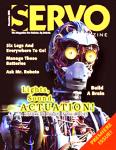 Soon virtually every aspect of human activity will be
influenced by robotics. Advances in medicine, space exploration, security, maintenance,
transportation, agriculture, manufacturing, retailing, and more will become dependent on
intelligent machines programmed to carry out ever-increasingly difficult tasks. Advances
in robotics will be as dynamic and important as those of computers in the 80s and 90s.
Just as with computers, hobbyists will be a driving force in their evolution. Servo
will be there to take you inside this fascinating world of science and technology.
Soon virtually every aspect of human activity will be
influenced by robotics. Advances in medicine, space exploration, security, maintenance,
transportation, agriculture, manufacturing, retailing, and more will become dependent on
intelligent machines programmed to carry out ever-increasingly difficult tasks. Advances
in robotics will be as dynamic and important as those of computers in the 80s and 90s.
Just as with computers, hobbyists will be a driving force in their evolution. Servo
will be there to take you inside this fascinating world of science and technology.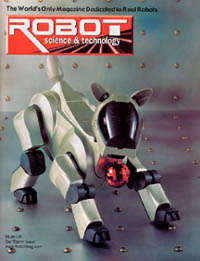 Getting Started In Robotic Vision
with MindStorms Vision Command
Getting Started In Robotic Vision
with MindStorms Vision Command AIBO
Second Generation: New & Improved
AIBO
Second Generation: New & Improved  Multitasking
the 68HC11 Robot Brain
Multitasking
the 68HC11 Robot Brain 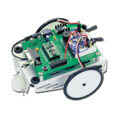 Basic
Branching and Servo Control
Basic
Branching and Servo Control  Crash-n-Burn
Sumo Robot
Crash-n-Burn
Sumo Robot  A Simple Circuit to Make Stiquito Walk on Its Own
A Simple Circuit to Make Stiquito Walk on Its Own  Build
Your Own Robot Mini-Sumo
Build
Your Own Robot Mini-Sumo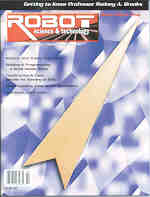 OWI Robotic Arm Trainer
OWI Robotic Arm Trainer Sensing & Locomotion
Sensing & Locomotion  Winning
Against the Obstacles With a Modified GrowBot Kit
Winning
Against the Obstacles With a Modified GrowBot Kit Bringing Martian Technology Down to Earth
Bringing Martian Technology Down to Earth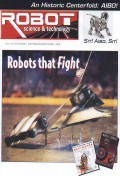 The
C* Algorithm
The
C* Algorithm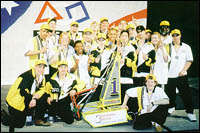
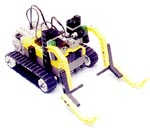 Ideabolts Galore with LEGO Mindstorms
Ideabolts Galore with LEGO Mindstorms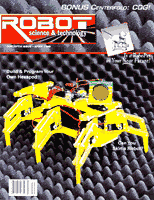 Fluffy, The Convertible Robot:
Fluffy, The Convertible Robot: Popular Micromouse
Algorithms, Part IV:
Popular Micromouse
Algorithms, Part IV: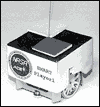 So, how in the world do
you get robots to cooperate in team sports? This concluding article by Mohammed Jamshidi,
PhD., Denise Padilla, and Marco de Oliveira explores fuzzy control, fuzzy behavior, and
genetic algorithms and how their interactions can be employed by a team of robots to play
soccer. Well, now that robots can play soccer, tennis anyone?
So, how in the world do
you get robots to cooperate in team sports? This concluding article by Mohammed Jamshidi,
PhD., Denise Padilla, and Marco de Oliveira explores fuzzy control, fuzzy behavior, and
genetic algorithms and how their interactions can be employed by a team of robots to play
soccer. Well, now that robots can play soccer, tennis anyone?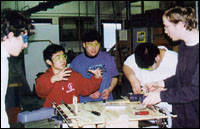 The
FIRST organization presents one of the worlds largest robotic competitions. Floyd Painter,
our own esteemed Editor-in-Chief, chronicles some of the challenges faced by the Harry M.
Gunn High School of Palo Alto, California FIRST Team in their quest to develop a winning
strategy for their robot G-Force. Going for the glory, the team decides they want a
quarterback robot that can do it all.
The
FIRST organization presents one of the worlds largest robotic competitions. Floyd Painter,
our own esteemed Editor-in-Chief, chronicles some of the challenges faced by the Harry M.
Gunn High School of Palo Alto, California FIRST Team in their quest to develop a winning
strategy for their robot G-Force. Going for the glory, the team decides they want a
quarterback robot that can do it all.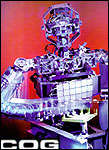
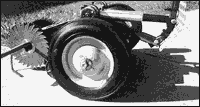 Lots of hardware! An
ammunition box for the main frame, hacked kiddy car motors driving the wheels through a
100 to 1 gear reduction system for motive power with plenty of torque, electricity
supplied by two big Yuasa MPH 1-12 batteries good for 100 Amps or more all add up to quite
a powerful package. Ronni Katz finishes off her Chew Toy robot warrior article with
some great advice and a whole lot of resources detailing where you can find whatever you
may need to build your own warrior.
Lots of hardware! An
ammunition box for the main frame, hacked kiddy car motors driving the wheels through a
100 to 1 gear reduction system for motive power with plenty of torque, electricity
supplied by two big Yuasa MPH 1-12 batteries good for 100 Amps or more all add up to quite
a powerful package. Ronni Katz finishes off her Chew Toy robot warrior article with
some great advice and a whole lot of resources detailing where you can find whatever you
may need to build your own warrior.
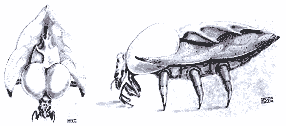
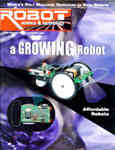 A Growing (and affordable) Robot
A Growing (and affordable) Robot Imagine yourself as part of a tumultuous crowd of ten thousand screaming fans,
decked out in team colors and cheering for your squad. Cheerleaders, mascots, banners
waving, elated fans surging and urging the players on. This crush of humanity you are part
of must be watching a game during the state basketball tournament, or could it be football
delirium right? Neither is the case; the athletes performing on the playing surface are
unique, original radio-controlled robots built by teams of high school students. The ten
thousand enthusiastic spectators are real: They were attending the 1998 national finals of
the robotics competition sponsored by the FIRST Foundation (For Inspiration and
Recognition of Science and Technology). This is the story of FIRST, and some of the people
who made that exciting scenario possible.
Imagine yourself as part of a tumultuous crowd of ten thousand screaming fans,
decked out in team colors and cheering for your squad. Cheerleaders, mascots, banners
waving, elated fans surging and urging the players on. This crush of humanity you are part
of must be watching a game during the state basketball tournament, or could it be football
delirium right? Neither is the case; the athletes performing on the playing surface are
unique, original radio-controlled robots built by teams of high school students. The ten
thousand enthusiastic spectators are real: They were attending the 1998 national finals of
the robotics competition sponsored by the FIRST Foundation (For Inspiration and
Recognition of Science and Technology). This is the story of FIRST, and some of the people
who made that exciting scenario possible. Designing
and building a robot is an exciting and challenging project, and you have several choices
to make early in the process. You need to decide if it will be expensive or inexpensive,
big or small, smart or not? Will it walk or will it roll, and will it be required to
traverse flat or rough surfaces? Sometimes the answers to these questions are influenced
by your financial resources. If your robot must be inexpensive, or you are just starting
out in robotics and want to keep it simple, a practical solution for you is an insectoid
robot. This feature article is about small, thin insect-like robots that use artificial
muscles for propulsion, and nitinol, the enabling element in these robots.
Designing
and building a robot is an exciting and challenging project, and you have several choices
to make early in the process. You need to decide if it will be expensive or inexpensive,
big or small, smart or not? Will it walk or will it roll, and will it be required to
traverse flat or rough surfaces? Sometimes the answers to these questions are influenced
by your financial resources. If your robot must be inexpensive, or you are just starting
out in robotics and want to keep it simple, a practical solution for you is an insectoid
robot. This feature article is about small, thin insect-like robots that use artificial
muscles for propulsion, and nitinol, the enabling element in these robots. Over two thousand years ago a Chinese warrior-philosopher named Sun Tzu wrote a
book called The Art of War. The lessons in that book can be applied to a wide
range of modern day problems. Business managers scour the book for lessons in business
administration, politicians use the teachings to outmaneuver their political foes, and
even after all these years, the military can still find some important lessons in The
Art of War. With such wide-ranging utility, it would be surprising if there was not a
lesson or two in the book for a person who is involved in a robot competition. Imagine
that instead of a great military leader, Sun Tzu was a champion robot wrangler who penned
wise and poetic lessons about the art of robot war. This feature examines what Sun Tzu may
have been trying to tell us aspiring robot champions.
Over two thousand years ago a Chinese warrior-philosopher named Sun Tzu wrote a
book called The Art of War. The lessons in that book can be applied to a wide
range of modern day problems. Business managers scour the book for lessons in business
administration, politicians use the teachings to outmaneuver their political foes, and
even after all these years, the military can still find some important lessons in The
Art of War. With such wide-ranging utility, it would be surprising if there was not a
lesson or two in the book for a person who is involved in a robot competition. Imagine
that instead of a great military leader, Sun Tzu was a champion robot wrangler who penned
wise and poetic lessons about the art of robot war. This feature examines what Sun Tzu may
have been trying to tell us aspiring robot champions. The
centerfold of the November issue of RS&T, the Sony entertainment-type robot, is a
prime example of how cool a robot can look with a little extra effort! In this
continuation of our fabrication series, we acquaint you with a technique you can use to
clothe your robot in a sleek outer garment. Just think, no more dangling wires, sharp
edges, or disconcerting metallic glare to distract you from the graceful movements of your
robot as it goes about its assigned tasks! In keeping with the basic philosophy of this
series, vacuforming is something you can do in your own home. You can do this in your
kitchen.
The
centerfold of the November issue of RS&T, the Sony entertainment-type robot, is a
prime example of how cool a robot can look with a little extra effort! In this
continuation of our fabrication series, we acquaint you with a technique you can use to
clothe your robot in a sleek outer garment. Just think, no more dangling wires, sharp
edges, or disconcerting metallic glare to distract you from the graceful movements of your
robot as it goes about its assigned tasks! In keeping with the basic philosophy of this
series, vacuforming is something you can do in your own home. You can do this in your
kitchen. Autonomous Soccer Robots
Autonomous Soccer Robots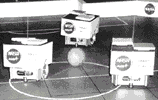 In today's fast moving technological world, intelligent
techniques of incorporating reasoning, learning, perception, and coordination into
analysis and design philosophies of systems seems to be an unavoidable eventuality. At the
NASA Center for Autonomous Control Engineering (ACE) of the University of New Mexico,
students and faculty researchers are using soft computing techniques to create autonomous
control paradigms to provide 'intelligence' to robots. One of the current research topics
at NASA ACE in robotics is the use of multiple autonomous robots for the cooperative
execution of tasks. In this Part I of a two part series, fuzzy logic and fuzzy control are
discussed.
In today's fast moving technological world, intelligent
techniques of incorporating reasoning, learning, perception, and coordination into
analysis and design philosophies of systems seems to be an unavoidable eventuality. At the
NASA Center for Autonomous Control Engineering (ACE) of the University of New Mexico,
students and faculty researchers are using soft computing techniques to create autonomous
control paradigms to provide 'intelligence' to robots. One of the current research topics
at NASA ACE in robotics is the use of multiple autonomous robots for the cooperative
execution of tasks. In this Part I of a two part series, fuzzy logic and fuzzy control are
discussed.  Researchers from Carnegie Mellon University (CMU), and the Sony Corporation
collaborated on this article about legged robots at RoboCup'98. RoboCup is held annually,
coincident with the human World Cup soccer tournament. Last year an informal league of
three teams equipped with Sony's innovative, fully autonomous quadrupeds, competed in an
exhibition series won by the CMTrio team. Robotic soccer represents a very challenging
environment in which multiple robots, acting as teammates, work together to achieve
objectives in the presence of adversaries. Problem solving in this environment requires
that the robots learn from experience and feedback. To achieve this, the CMTrio built into
the robots learning, navigation, localization and role-based behavior capabilities that
allowed them to operate as teammates on a small soccer field.
Researchers from Carnegie Mellon University (CMU), and the Sony Corporation
collaborated on this article about legged robots at RoboCup'98. RoboCup is held annually,
coincident with the human World Cup soccer tournament. Last year an informal league of
three teams equipped with Sony's innovative, fully autonomous quadrupeds, competed in an
exhibition series won by the CMTrio team. Robotic soccer represents a very challenging
environment in which multiple robots, acting as teammates, work together to achieve
objectives in the presence of adversaries. Problem solving in this environment requires
that the robots learn from experience and feedback. To achieve this, the CMTrio built into
the robots learning, navigation, localization and role-based behavior capabilities that
allowed them to operate as teammates on a small soccer field.  Plastic
Gear Fabrication
Plastic
Gear Fabrication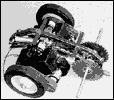 If you are thinking about entering in a robotic combat
competition, here are some very useful tips on how to prepare. Ronni has competed in the
past two Robot Wars and will have three different designs to enter the next competition.
In this article, she uses her lightweight design "Chew Toy" as the
example model. Of the three possible entries, this one is the most basic and the one that
will actually be a "garage built" robot using easily obtainable parts and tools
that most builders either already own or can acquire with ease.
If you are thinking about entering in a robotic combat
competition, here are some very useful tips on how to prepare. Ronni has competed in the
past two Robot Wars and will have three different designs to enter the next competition.
In this article, she uses her lightweight design "Chew Toy" as the
example model. Of the three possible entries, this one is the most basic and the one that
will actually be a "garage built" robot using easily obtainable parts and tools
that most builders either already own or can acquire with ease.  Of Algorithms and Micromice
Of Algorithms and Micromice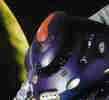 Big Bad
Blue Steals the Show
Big Bad
Blue Steals the Show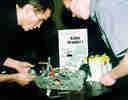 The
Tech Museum of Innovation in San Jose believes you're never too young to start learning
about robotics. Every year, The Tech sponsors a robot-building contest for elementary,
junior high and high school students in the Silicon Valley and environs. RS&T's news
and feature editor Tom Durkin covered Tech Challenge 98 last April to find out what it is
all about. Tom reports it was all about learning-by-doing -- and having a heck of a lot of
fun doing it. In addition to reporting on the contest itself in "Silicon Valley's
Best and Brightest Take on Tech Challenge 98," Tom profiles two teams in
"Ingenious Ingenues" and "Winning Isn't Everything." What was this
year's Tech Challenge? Pick up a copy of RS&T's July '98 issue and start reading on
Page 26.
The
Tech Museum of Innovation in San Jose believes you're never too young to start learning
about robotics. Every year, The Tech sponsors a robot-building contest for elementary,
junior high and high school students in the Silicon Valley and environs. RS&T's news
and feature editor Tom Durkin covered Tech Challenge 98 last April to find out what it is
all about. Tom reports it was all about learning-by-doing -- and having a heck of a lot of
fun doing it. In addition to reporting on the contest itself in "Silicon Valley's
Best and Brightest Take on Tech Challenge 98," Tom profiles two teams in
"Ingenious Ingenues" and "Winning Isn't Everything." What was this
year's Tech Challenge? Pick up a copy of RS&T's July '98 issue and start reading on
Page 26. 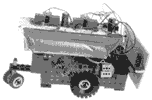 Do-It-Yourself
TuteBot
Do-It-Yourself
TuteBot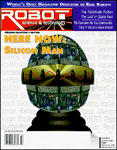 Aluminum:
The Not So Heavy Metal
Aluminum:
The Not So Heavy Metal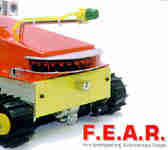 Putting FEAR and Marv into Fire Fighting
Putting FEAR and Marv into Fire Fighting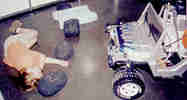 A very hacked RC toy Jeep and a very expensive industrial robot have been
mated as a "marsupial" search-and-rescue team by the faculty and staff of the
Colorado School of Mines. The semi-autonomous mother bot Silver Bullet carries 60-pound
baby bot Bujold in a Plexiglas pouch to the scene of an urban disaster. When Silver Bullet
locates a possible victim trapped in the rubble, she launches the shape-shifting Bujold to
crawl in for a closer look. To find out more about how this prototype robot team will
change urban search-and-rescue methods and save more lives, see Page 34 of the Premier
issue.
A very hacked RC toy Jeep and a very expensive industrial robot have been
mated as a "marsupial" search-and-rescue team by the faculty and staff of the
Colorado School of Mines. The semi-autonomous mother bot Silver Bullet carries 60-pound
baby bot Bujold in a Plexiglas pouch to the scene of an urban disaster. When Silver Bullet
locates a possible victim trapped in the rubble, she launches the shape-shifting Bujold to
crawl in for a closer look. To find out more about how this prototype robot team will
change urban search-and-rescue methods and save more lives, see Page 34 of the Premier
issue.